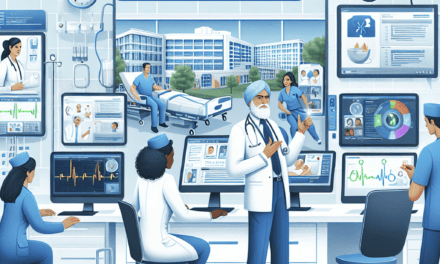The Life-Saving Impact of Occupational Health and Safety Education on Healthcare Efficiency
Occupational health and safety (OHS) education is a critical component of healthcare systems worldwide. It not only protects healthcare workers but also enhances the overall efficiency of healthcare delivery. This article explores the multifaceted impact of OHS education on healthcare efficiency, focusing on five key areas: the importance of OHS education, its role in reducing workplace injuries, its influence on patient safety, its contribution to healthcare worker morale and retention, and the economic benefits of implementing OHS programs. Each section will provide detailed insights, supported by relevant examples and statistics.
1. The Importance of Occupational Health and Safety Education
Occupational health and safety education is essential for creating a safe working environment, particularly in the healthcare sector, where workers are exposed to various hazards. The World Health Organization (WHO) emphasizes that a well-educated workforce is crucial for maintaining health and safety standards. OHS education encompasses training on recognizing hazards, understanding safety protocols, and implementing preventive measures.
Healthcare workers face unique challenges, including exposure to infectious diseases, chemical hazards, and physical injuries. According to the Bureau of Labor Statistics, healthcare workers experience higher rates of injury and illness compared to other industries. This underscores the need for comprehensive OHS education that equips workers with the knowledge and skills to mitigate risks.
Moreover, OHS education fosters a culture of safety within healthcare organizations. When employees are educated about safety protocols, they are more likely to adhere to them, leading to a reduction in accidents and injuries. This culture of safety not only protects workers but also enhances patient care by ensuring that healthcare providers are operating in a safe environment.
- Enhanced Awareness: OHS education raises awareness about potential hazards in the workplace, enabling healthcare workers to identify and address risks proactively.
- Regulatory Compliance: Many countries have regulations mandating OHS training for healthcare workers, ensuring that organizations comply with legal standards.
- Improved Communication: OHS education promotes better communication among staff regarding safety concerns, fostering teamwork and collaboration.
In summary, the importance of OHS education cannot be overstated. It is a foundational element that supports the health and safety of healthcare workers, ultimately leading to improved healthcare efficiency.
2. Reducing Workplace Injuries through OHS Education
Workplace injuries in healthcare settings can have devastating consequences, not only for the affected workers but also for the healthcare system as a whole. OHS education plays a pivotal role in reducing these injuries by providing workers with the knowledge and skills necessary to navigate their work environments safely.
One of the most common types of injuries in healthcare is musculoskeletal disorders (MSDs), often resulting from lifting and moving patients. According to the National Institute for Occupational Safety and Health (NIOSH), healthcare workers are at a significantly higher risk of developing MSDs compared to workers in other industries. OHS education programs that focus on proper lifting techniques and ergonomic practices can significantly reduce the incidence of these injuries.
For example, a study conducted at a large hospital in California implemented a comprehensive OHS training program that included ergonomic assessments and safe patient handling techniques. As a result, the hospital reported a 30% decrease in MSD-related injuries over two years. This not only improved worker safety but also reduced the associated costs of workers’ compensation claims.
In addition to MSDs, healthcare workers are also at risk of exposure to infectious diseases, such as hepatitis B and HIV. OHS education programs that emphasize infection control practices, such as proper hand hygiene and the use of personal protective equipment (PPE), are essential in minimizing these risks. A study published in the American Journal of Infection Control found that hospitals with robust OHS training programs experienced lower rates of healthcare-associated infections (HAIs), benefiting both staff and patients.
- Injury Prevention Strategies: OHS education equips workers with strategies to prevent injuries, such as using assistive devices for patient handling.
- Infection Control Training: Training on infection control measures helps reduce the risk of disease transmission among healthcare workers.
- Regular Safety Drills: Conducting regular safety drills as part of OHS education ensures that staff are prepared for emergencies, further reducing injury risks.
In conclusion, OHS education is instrumental in reducing workplace injuries in healthcare settings. By equipping workers with the necessary knowledge and skills, healthcare organizations can create safer environments that protect both employees and patients.
3. The Influence of OHS Education on Patient Safety
Patient safety is a paramount concern in healthcare, and OHS education plays a crucial role in enhancing it. A safe working environment for healthcare workers directly correlates with improved patient outcomes. When healthcare providers are well-trained in safety protocols, they are better equipped to deliver high-quality care.
One significant aspect of OHS education is the training on medication safety. Errors in medication administration can have severe consequences for patients. A study published in the Journal of Patient Safety found that hospitals with comprehensive OHS training programs reported fewer medication errors. This is attributed to the emphasis on double-checking medications, understanding drug interactions, and adhering to safety protocols.
Furthermore, OHS education fosters a culture of reporting and learning from errors. When healthcare workers are educated about the importance of reporting near misses and adverse events, organizations can implement corrective actions to prevent future occurrences. For instance, a hospital that encouraged reporting through OHS training saw a 40% increase in reported near misses, leading to significant improvements in patient safety protocols.
In addition to medication safety, OHS education also addresses infection control practices, which are critical for preventing HAIs. Training on proper hand hygiene, sterilization techniques, and the use of PPE can significantly reduce the risk of infections. The Centers for Disease Control and Prevention (CDC) reports that effective infection control measures can reduce HAIs by up to 70%, highlighting the importance of OHS education in this area.
- Medication Administration Training: OHS education includes training on safe medication practices, reducing the likelihood of errors.
- Error Reporting Culture: Encouraging a culture of reporting fosters continuous improvement in patient safety protocols.
- Infection Control Measures: Training on infection control practices is essential for minimizing the risk of HAIs.
In summary, OHS education significantly influences patient safety by equipping healthcare workers with the knowledge and skills necessary to provide safe and effective care. By prioritizing OHS education, healthcare organizations can enhance patient outcomes and reduce the risk of adverse events.
4. Enhancing Healthcare Worker Morale and Retention
The morale and retention of healthcare workers are critical factors in maintaining an efficient healthcare system. High turnover rates can lead to staffing shortages, increased workloads for remaining staff, and ultimately, compromised patient care. OHS education plays a vital role in enhancing worker morale and retention by fostering a safe and supportive work environment.
When healthcare workers feel safe in their work environment, they are more likely to be satisfied with their jobs. A study published in the Journal of Occupational Health Psychology found that employees who received OHS training reported higher job satisfaction and lower levels of burnout. This is particularly important in the healthcare sector, where workers often face high levels of stress and emotional exhaustion.
Moreover, OHS education demonstrates an organization’s commitment to the well-being of its employees. When healthcare organizations invest in OHS training, it sends a message that they value their workers’ health and safety. This can lead to increased loyalty and a sense of belonging among staff. For example, a hospital that implemented a comprehensive OHS program reported a 25% decrease in turnover rates over three years, highlighting the positive impact of OHS education on employee retention.
Additionally, OHS education can empower healthcare workers by providing them with the knowledge and skills to advocate for their safety. When employees are educated about their rights and responsibilities regarding workplace safety, they are more likely to speak up about unsafe conditions. This empowerment can lead to a more engaged workforce and a culture of safety within the organization.
- Job Satisfaction: OHS education contributes to higher job satisfaction by creating a safer work environment.
- Employee Loyalty: Investing in OHS training fosters loyalty among healthcare workers, reducing turnover rates.
- Empowerment: Educated employees are more likely to advocate for their safety, leading to a proactive safety culture.
In conclusion, OHS education is a key factor in enhancing healthcare worker morale and retention. By prioritizing the health and safety of employees, healthcare organizations can create a positive work environment that benefits both staff and patients.
5. The Economic Benefits of Implementing OHS Programs
Implementing effective occupational health and safety programs in healthcare settings not only protects workers but also yields significant economic benefits. The costs associated with workplace injuries, illnesses, and accidents can be substantial, impacting both healthcare organizations and the broader economy.
According to the National Safety Council, workplace injuries cost employers over $170 billion annually in direct and indirect costs. These costs include medical expenses, lost wages, and decreased productivity. By investing in OHS education and training, healthcare organizations can reduce these costs significantly. For instance, a study conducted by the Occupational Safety and Health Administration (OSHA) found that for every dollar spent on workplace safety programs, employers can expect a return of $4 in reduced costs.
Moreover, reducing workplace injuries through OHS education can lead to lower workers’ compensation premiums. Insurance companies often offer discounts to organizations that demonstrate a commitment to safety through training and education. This can result in substantial savings for healthcare organizations, allowing them to allocate resources to other critical areas, such as patient care and staff development.
Additionally, OHS education can enhance productivity by reducing absenteeism and turnover rates. When healthcare workers feel safe and supported, they are less likely to take time off due to injuries or stress-related issues. A study published in the Journal of Occupational and Environmental Medicine found that organizations with strong safety cultures experienced 30% lower absenteeism rates compared to those without such cultures.
- Cost Savings: Investing in OHS programs can lead to significant cost savings by reducing workplace injuries and associated expenses.
- Lower Insurance Premiums: Organizations that prioritize safety may benefit from lower workers’ compensation premiums.
- Increased Productivity: A safe work environment leads to higher productivity levels and reduced absenteeism among healthcare workers.
In summary, the economic benefits of implementing OHS programs in healthcare settings are substantial. By investing in OHS education, healthcare organizations can reduce costs, enhance productivity, and ultimately improve the quality of care provided to patients.
Conclusion
The life-saving impact of occupational health and safety education on healthcare efficiency is profound. By prioritizing OHS education, healthcare organizations can create safer work environments that protect employees and enhance patient care. The importance of OHS education extends beyond compliance with regulations; it fosters a culture of safety, reduces workplace injuries, improves patient safety, enhances worker morale and retention, and provides significant economic benefits.
As the healthcare landscape continues to evolve, the need for effective OHS education will only grow. By investing in the health and safety of healthcare workers, organizations can ensure a more efficient and effective healthcare system that ultimately benefits everyone involved. The commitment to OHS education is not just a legal obligation; it is a moral imperative that can save lives and improve the quality of care in our communities.





